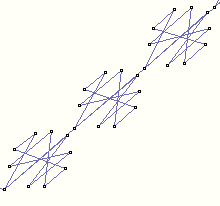Repetition
With the switch the bean stitch can be activated or deactivated.
If it is activated, the value behind it defines the width of the “bean”, the value stitches defines the number of stitches per “bean”.
If the width is set to zero, the stitch is repeated several times, but not with equal stitch lengths, but the stitches start short and with each repetition the stitch becomes longer.
 Ist he width larger than zero, the stitch is repeated but not with equal stitch lengths, but the stitches start short and with each repetition the stitch becomes longer. Additionally the first stitch starts at the maximum value in the width and every following stitch become smaller as long as the last stitch is at the original position.
Ist he width larger than zero, the stitch is repeated but not with equal stitch lengths, but the stitches start short and with each repetition the stitch becomes longer. Additionally the first stitch starts at the maximum value in the width and every following stitch become smaller as long as the last stitch is at the original position.
Is the stitch number 1 a simple stitch is calculated, is the stitch number 3, a bean stitch without any width is calculated.
If the bean stitch is not activated, the parameter have the following effects:
The repetition factor for the individual stitches can be defined here as a value between 1 and 99. The program will however only accept uneven values, should an even value be input, this is converted to the next higher uneven value. Only with uneven repetition factors is it possible to continue to the next stitch.
The inputting of the a value greater than 1 means that the entire running line is reworked several times, this produces a so called duplicate line. Valid repetition values lie between 1 and 5. It should be noted that for an even number of repetitions, the start and end points of a duplicate line are the same point.
Created with the Personal Edition of HelpNDoc: Write eBooks for the Kindle